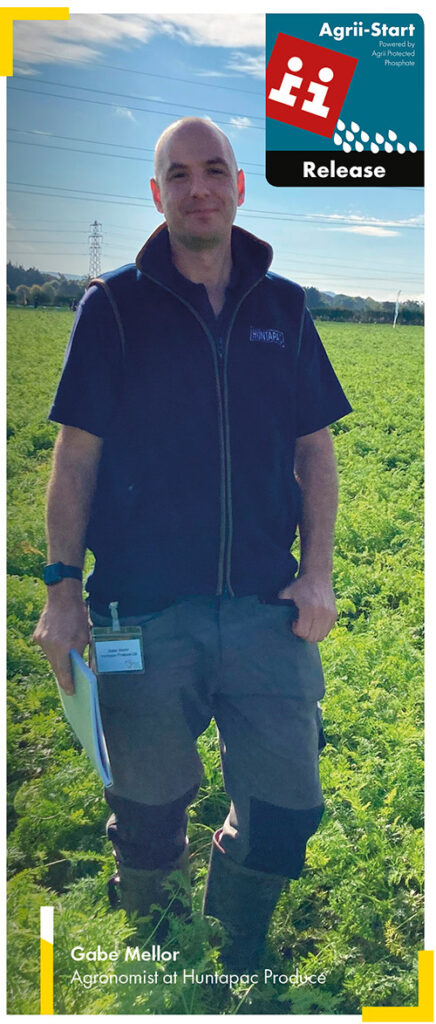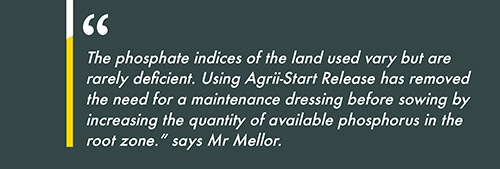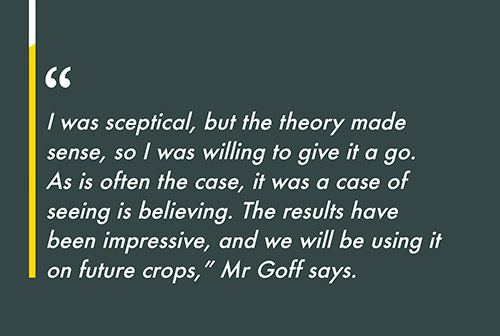
Huntapac Produce, one of Britain’s biggest growers of root crops with activities from Suffolk to Scotland, first used Agrii-Start Release in 2021 on roughly 200 hectares of carrots across North Yorkshire. Following a positive experience, this has been extended to include parsnips and is now applied to the entire carrot and parsnip crop area across Yorkshire and Shropshire.
The phosphate indices of the land used vary but are rarely deficient. Using Agrii-Start Release has removed the need for a maintenance dressing before sowing by increasing the quantity of available phosphorus in the root zone.
In a typical soil, roughly 80% of the phosphorus is unavailable for plant uptake despite many soils having a healthy reserve. This is largely due to the low solubility of the calcium or aluminium salts to which the phosphate molecules are bound.
“Before adopting Agrii-Start Release, we would apply roughly 50kg P/ha prior to sowing,” Gabe Mellor, company agronomist, explains.
“Applying Agrii-Start Release at a rate of 4 l/ha in 2-300 litres of water shortly before being incorporated to a depth of 3 to 4cm serves to increase the available portion in the soil and therefore remove the need for an application of granular phosphate. This is a far more cost-effective solution to meeting crop requirements and supports our efforts to reduce the carbon footprint of the crop,” he adds.

Spearhead Group has been working with Agrii for several years, with Agrii providing support to the company’s in-house crop trials. It was through this relationship that Spearhead was introduced to Agrii-Start Release.
For Nick Goff, trials manager with Greenseed International, a division of Spearhead International focused on seed and table potatoes, admits to being won over by Agrii-Start Release’s performance.

“I was sceptical, but the theory made sense, so I was willing to give it a go. As is often the case, it was a case of seeing is believing. The results have been impressive, and we will be using it on future crops,” Mr Goff says.
Many of Greenseed’s crops are grown on chalky land, so the potential for phosphate to be rendered unavailable by the calcium ions in the soil, especially as the soil warms, presents a nutrient management challenge. In past seasons, the effects of this chemical reaction have been mitigated through large applications of solid fertiliser products, but this has also come at a significant cost.
“A soil-applied phosphorus activator has great appeal given the role of phosphate in increasing early crop development, haulm growth, tuber initiation and early bulking.
“As salad and seed growers, our potato crops are in the ground for a relatively short duration compared with main crop potatoes, so the phosphate needs to be available early and in sufficient quantity to meet demand if crops are to meet size and quality requirements,” he adds.
As phosphate is relatively immobile, it is important that it is incorporated or placed in the seedbed at planting to maximise its value.
“When we studied the trials data for Agrii-Start Release, we quickly realised its potential. We were especially interested in the immediacy of its effect in increasing phosphate availability post-application but wanted to see this benefit delivered at scale.

Trials manager with Greenseed International
“The trials we have seen involving Agrii-Start Release have been at a commercial scale, and this gave us the confidence to apply it to our seed and salad crops across East Anglia, which is roughly 650 ha,” Mr Goff says.
The effect has been evident. “Through the spring period, crops appeared visibly healthier. We validated this with tissue testing, and where we would have expected crops to be deficient in phosphate based on past experience, we found them to be at the required levels. We have also seen that tuber numbers are at the higher end of our expected range.
“This observation has been supported by root digs in the split-field trial, where we have seen more tubers per plant and greater uniformity in the treated crop. In the world of salad potatoes, uniformity is essential. Under 28mm is too small, and more than 45mm is too big. The use of Agrii-Start Release has significantly increased the marketable fraction,” Mr Goff says.
For more information, visit agrii.co.uk/our-services/fertiliser/agrii-start/release.



